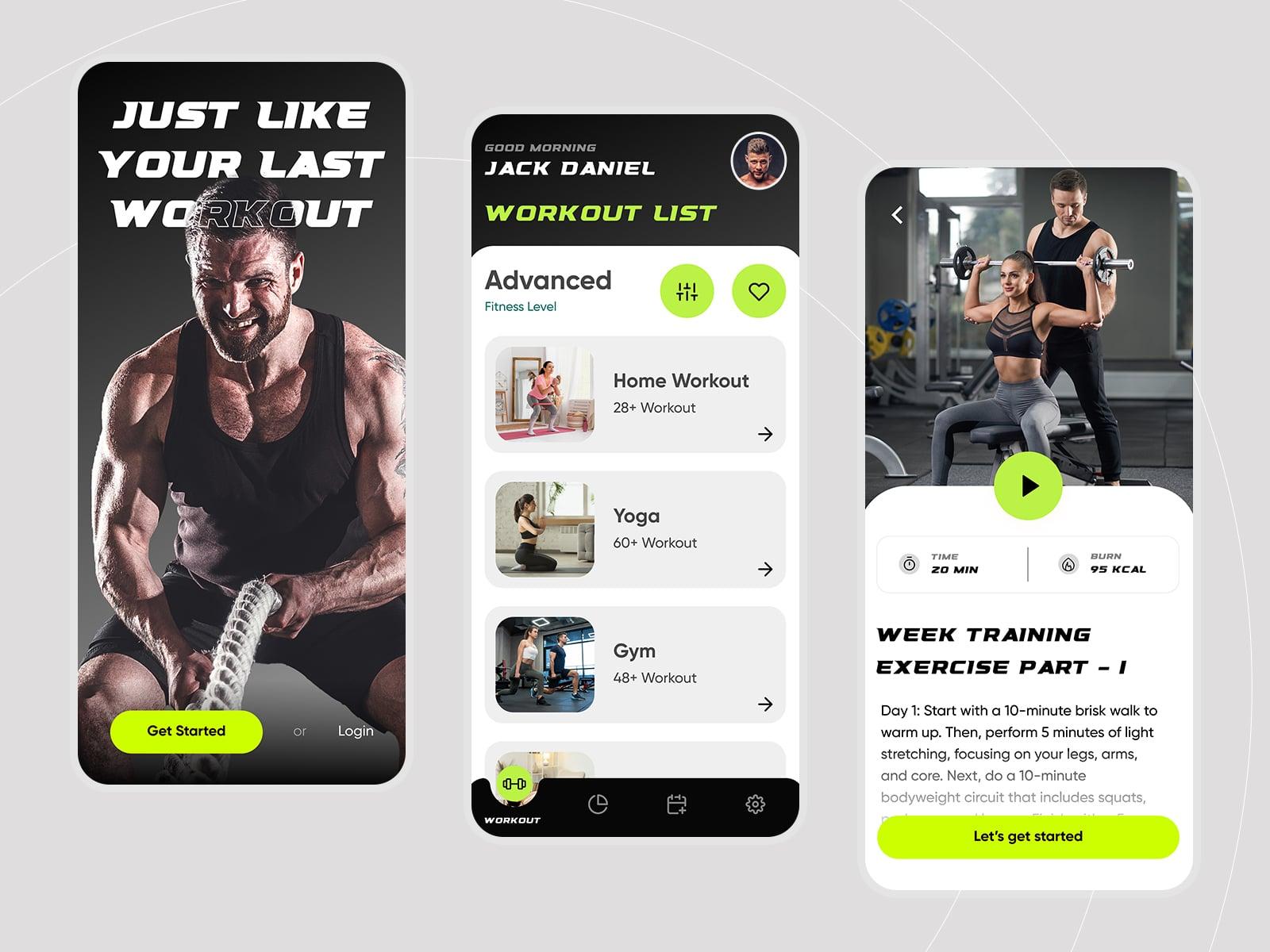Fitness app demand has increased over the years due to the digital transformation of the health and wellness industries. Fitness apps offer people on-demand solutions for health and fitness, including finding a coach to consult online or offline, tracking fitness levels, like BMI, BMR, and water retention, and even finding a personal trainer. Fitness apps also allow users to monitor their daily nutrition, including carbs, protein, and fiber intake.
The demand for fitness apps that are feature-rich and geared towards the customer is on the rise. The market for digital fitness and well-being applications is expected to grow 12.30% from 2023 to 2028. This will add to the US$25.40bn that this market volume will reach in 2028.
The development of health and fitness apps has the potential to be a valuable tool for people, service providers, and communities. You can reap the benefits of developing a fitness application, whether you’re an entrepreneur or a business.
Learn how to develop a fitness application, including the process, costs, features, and tech stack.
Fitness App Industry Market Overview – What are the benefits of fitness app development?
The global market for mobile health and fitness apps has grown significantly in recent years. This growth is driven by factors like:
-
Smartphones and other wearable devices are becoming increasingly popular.
-
Fitness and wellness are becoming increasingly important.
-
Health awareness is on the rise amongst the population.
Many applications on the market help users monitor their physical activity and maintain healthy lifestyles. They also assist them in achieving their fitness goals. Fitbit, MyFitnessPal, Nike, Under Armour, Runtastic GmbH, Adidas AG, Asics Corporation, Azumio, Inc., Garmin Ltd., and Google Fit LLC, are some of the leading global fitness app market players. These companies invest continuously in product development, partnerships, and acquisitions, to increase their target audience and improve user experience.
The fitness apps market will grow to $120.37 Billion by 2030. This represents a CAGR between 2021 and 3031 of 24.3%. This growth can be attributed to several factors.
Due to technological advances, increasing consumer awareness of health, and the popularity of wearable devices.
It is therefore wise to invest in fitness app development. When launching a fitness application, it’s important to determine your target audience, the type of app you want to develop, and the niche that fits within this huge market.
How to Choose the Right Category when Developing Fitness Apps?
Digital fitness and wellbeing apps are often focused on tracking health, exercising, managing stress, and providing online home remedies. Fitness apps are available in many different types.
-
Activity Tracking Apps
-
Nutrition And Diet Apps
-
Yoga and Meditation Apps
-
Workout Apps
We’ll help you understand the impact of each app on daily life by analyzing its scope.
1. App Development for Fitness Tracking
Fitness or activity-tracking apps are widely used fitness applications developed for smartphones and wristwatches. These apps use the sensors on your smartphone or wearable device to track and monitor physical activity.
This app gathers data using accelerometers and GPS. The app tracks metrics like steps taken, distance traveled, calories burnt, and active minutes while walking, running, or cycling.
Fitness enthusiasts and those who are new to fitness will benefit from activity-tracking apps, which encourage a healthier lifestyle and help users achieve their fitness goals. Google Fit is a great example of an activity-tracking app.
2. Nutrition And Diet Apps
A majority of people are now conscious of the food they consume each day, in addition to exercising or participating in physical activities. A nutrition and diet planner application is therefore one of the most sought-after fitness app development expertise areas.
These apps offer a variety of features such as meal planning and tracking nutrient intake. They provide valuable insight into the eating habits of users. These apps promote healthy eating habits by providing comprehensive food databases, personalized diet plans, and recipe recommendations tailored to each individual’s needs and goals.
These apps may also offer customized meal plans, recipe suggestions, and dietitian assistance. It helps users to make informed decisions, reach their nutritional goals, and improve overall health.
3. Yoga and Meditation Apps
Yoga and meditation apps are among the fastest-growing categories of fitness mobile app development. These apps promote holistic health by providing mindfulness, relaxation, and flexibility exercises. These apps offer guided yoga sessions, breathing exercises, and meditation exercises to suit users of all levels.
The user can customize their practice to suit their needs with the help of a variety of yoga styles and meditation features. They can also find detailed instructions. These apps encourage consistency by integrating progress tracking, personalized suggestions, and reminders.
Yoga and meditation apps also often feature progress tracking and timers for meditation to help users develop a consistent meditation practice and track progress over time. Yoga Studio, Headspace, and Calm are popular meditation and yoga apps.
4. Workout Apps
Apps that offer workout plans provide users with more options than traditional cardio or dance routines. Gamification features such as progress tracking, rewards, and social interaction are effective in increasing user engagement.
Create a workout application that provides unique experiences such as VR-based workouts, outdoor adventures, or story-driven exercises. This will motivate users and help you differentiate your app in the highly competitive fitness industry. A dynamic, captivating workout app can attract a wide audience and promote fitness success.
Fitness App Development: Must-have Features
Fitness app development is tailored to meet different needs and provides unique features for users. We’ve compiled a list of the essential features every fitness app must have. These features will improve your fitness app’s user experience and functionality.
1. Onboarding
Onboarding is a great way to introduce new users to the app and give them instructions. Onboarding is optional for the development of basic fitness apps. It can include a video tutorial or a few screens.
2. Sign Up & Login
Allow users to sign up with their favorite social media accounts, such as Facebook or Google. Sign-ups using personal email addresses will also ensure a smooth user experience.
3. User profiles
Users should have the ability to create profiles that include relevant information about themselves, such as their name, age, and gender. Both app administrators and users benefit from this data. The app admin can provide tailored workouts, trackers of physical activity, and customized plans. Profiles provide users with easy access to information such as subscription plans, history of exercise, tracking progress, bonuses, and other relevant details.
4. Goals
Fitness apps must include a fitness goal-setting feature. Allowing users to set goals and track their progress will add motivation and encourage adherence to fitness goals.
5. Synchronization with Wearable Devices
Your fitness app should integrate with wearable devices such as smartwatches, which are becoming more popular. Use APIs like HealthKit or GoogleFit for synchronizing fitness tracker data. Apple Watches and Android smartwatches can sync their data using the Wear OS and watchOS operating systems.
6. Exercises and Workouts
Exercises and workouts can be illustrated using a variety of media formats such as 3D animated models and video illustrations. Users should be able to choose whether they want to design their workouts or use a set of predefined exercises. This feature requires a searchable and organized content library.
7. Tracking
Apps can collect activity data via smartphone sensors or wearable trackers. Smartphones can provide information on distance traveled, steps taken, stairs climbed, speed, and direction. Samsung Health is a notable app in this area. Integration with third-party APIs is required to track additional parameters such as heart rate, body temperature, or sleep quality and synchronize fitness wearables.
8. Audio/Video Player
Audio and video components can enhance a variety of fitness activities such as running, yoga, meditation, or workouts. Podcasts with trainers’ voices or video tutorials are effective ways to guide users. Other features include feedback, bookmarking/liking of tracks, and resume playback in your fitness app.
9. Product & Recipe Database
Nutrition apps are characterized by a large database of healthy recipes and products, barcode scanning, nutrition analysis, and a wide range of product information. Additionally, adding items manually that aren’t listed in the app database gives users more flexibility.
10. Workout Customization
Allow users to customize workouts, diets, recipes, exercises, meditations, and exercise sets within the app. This feature is not easy to implement, but customer-centricity has become increasingly important in the current landscape.
11. Push Notifications and Reminders
Push notifications that are well-timed and specifically targeted can increase an app’s engagement rate from three to ten times. Push notifications can be used to remind and motivate users for their daily workouts, or provide healthcare insights.
12. Payment Method & Feature
It is easy to incorporate a payment option into your app, which allows you to monetize it. Users can easily subscribe to premium services, buy additional content, or access exclusive features within your fitness app by integrating a payment gateway such as PayPal or Visa.
13. Support & Customer Services
Consider implementing a chat function where support staff or trainers can offer real-time consultations and advice. If live chat is not available, chatbots that have pre-programmed answers can be used to provide automated support. Also, make sure that the contact information for your app is easily accessible. This will allow users to get in touch with you for help and provide a way for them to give valuable feedback.
14. Profile Setting
Profile settings allow users to customize their experience. Users can modify their passwords, email addresses, notification preferences, and account settings. Giving users control of their profiles increases their sense of ownership and allows them to customize the app according to their needs.
How to Create a Fitness App – Step-by-Step Guide
Depending on app categories, fitness apps may have three user panels: Fitness Coach, Admin, and End-user. An activity tracker, for example, allows users to optimize their health and track their fitness level and requires Admin and End-user panels. For example, an app that allows a personal trainer to provide online yoga or exercise sessions can have three user panels. One for the customer, one for the trainer, and one for the admin or owner.
Consider the business model that you would like to have for your fitness business before starting the app development process. To begin your app development journey, you will need to decide if you want to use native, cross-platform, or progressive web apps.
Step 1: Do Market Research to define the purpose of your app and its target audience
Do thorough research on the market, identify gaps in the market, and analyze your competition to determine the main goals for your fitness app. Understanding your target audience’s needs, motivations, and preferences will help you build a fitness application that is tailored to their needs.
Step 2: Design the app’s features
Determine the features that are essential to your fitness app based on your research. Your app’s features should have a unique value proposition that will help you stand out among your competitors.
Step 3: Select the right technology stack
Consider cross-platform compatibility and scalability when selecting the right technologies, frameworks, and tools for app development. Consider the framework you want to use, such as React Native, Flutter, or other similar platforms, and integrate third-party APIs into your health and fitness apps.
Step 4: Hire Fitness App Developers
Consider cost, commitment, project requirements, and availability when choosing the best team for your fitness app development project. You can hire the developers you prefer based on a variety of options.
Team in-house for direct communication and management.
You can hire an offshore fitness app company to access highly skilled professionals.
Freelancers with specialized skills and small-scale development.
You can read our guide to mobile app development costs to find out the costs of hiring developers in different countries.
Step 5: Create a UI/UX design that is user-friendly
Create a user interface that is intuitive, visually appealing, and easy to navigate. This will enhance the overall experience of users. The app should be accessible to users with different fitness levels.
Step 6: Create a Minimum Viable Product
Create a minimally viable version of your app, focusing primarily on the core features and functionalities. The MVP lets you test your app idea with real users and gather feedback before investing more time and resources in development.
Step 7: Start the development process for your fitness mobile app
Develop a fitness application with broader features and functionality based on the feedback you received from users during the MVP stage.
Step 8: Test the App
Test the app thoroughly to make sure it’s working properly. Consider a mix of manual and automatic testing and beta testing with actual users to collect valuable feedback and identify bugs or issues that need to be addressed.
Step 9: Launch the App
Release your app in the app stores that are appropriate for you, and follow their guidelines. To increase visibility, optimize your app store listing by adding relevant keywords, compelling descriptions, and attractive visuals.
Step 10: Monitor performance and user feedback
Monitor app usage, feedback from users, and ratings in app stores to identify areas for improvement and growth. Hire the best fitness app developers who can enhance and update your app according to market trends and user feedback. This will maintain user satisfaction and engagement.
How much does it cost to develop a fitness app?
Fitness app development costs in the minimum viable product (MVP version) range between $30,000 to $50,000. The cost of creating a fitness application can reach $300,000. This is because the app has many features and integrates intelligent technologies such as AI, AR/VR, or cloud.
The cost of fitness app development depends on several factors, including the project requirements, features, and technology, as well as the discovery phase. Contact a company that has experience in building similar apps for pricing information.
Are you ready to elevate your business with fitness app development?
We have extensive experience developing innovative fitness and health apps. Our fitness app, SmitFit, can be integrated with wearable devices and provide actionable insights to improve wellness.
We are a leading fitness and healthcare app developer with extensive experience creating end-to-end healthcare solutions, including wellness platforms. Our team of highly skilled backend developers and cloud professionals, who are all certified, work together to create a roadmap that will meet your app development needs.



